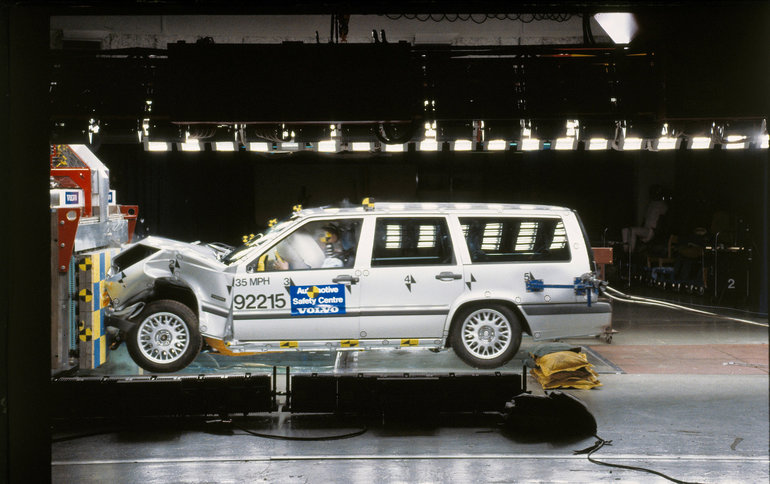Volvo's Safety Journey: A Legacy of Innovation Through the Decades
December 17 2024,

The evolution of automotive safety can be traced through Volvo's groundbreaking innovations. From the revolutionary three-point seatbelt to today's AI-powered safety systems, each decade has brought new advances that have transformed how we think about vehicle safety.
The 1950s: The Innovation That Changed Everything
1959 marked a pivotal moment in automotive history when Volvo engineer Nils Bohlin invented the three-point seatbelt. This revolutionary device would go on to save over one million lives. In an unprecedented move that demonstrated Volvo's commitment to universal safety, the company shared the patent freely with other manufacturers.
The 1970s: Protecting Our Most Precious Cargo
1970 saw the establishment of Volvo's Accident Research Team, beginning a systematic approach to studying real-world crashes that continues today. By 1972, Volvo revolutionized child safety by introducing the first rear-facing child seat, inspired by NASA's spacecraft seating designs. This was followed in 1978 by the first belt-positioned booster cushion, setting new standards for child protection.
The 1990s: The Safety Revolution Accelerates
The 1990s brought a wave of innovations that fundamentally changed vehicle safety:
- 1990: Introduction of the world's first integrated booster cushion
- 1991: Launch of the Side Impact Protection System (SIPS)
- 1995: Introduction of the first side airbags in the industry
- 1998: Development of the Whiplash Protection System (WHIPS) and introduction of the Inflatable Curtain airbag, protecting both front and rear passengers
The 2000s: Entering the Digital Age
The new millennium saw Volvo embrace electronic safety systems:
- 2002: Introduction of the Roll-Over Protection System (ROPS)
- 2003: Launch of the Blind Spot Information System (BLIS)
- 2008: Implementation of City Safety, the first standard-fit automatic emergency braking system
- 2010: Development of pedestrian detection with full auto brake
The 2010s: Connected Safety Takes Center Stage
This decade brought increasingly sophisticated safety technologies:
- 2014: Introduction of Run-off Road Protection
- 2016: Launch of Connected Safety, allowing Volvos to communicate with each other about road hazards
- 2018: Development of Oncoming Collision Mitigation
- 2019: Introduction of the EVA Initiative, sharing decades of safety research with the industry so that every driver can benefit.
The 2020s: Advancing Toward an Autonomous Future
Recent years have seen Volvo combine physical safety with advanced digital technologies:
- 2020: Implementation of speed limitation to 180 kilometres per hour on all new vehicles
- 2023: Introduction of the Driver Understanding System with dual cameras
- 2023: Integration of advanced LiDAR technology for enhanced detection
The Research Behind the Innovation
Throughout this timeline, Volvo's commitment to research has been unwavering. Since 1970, their Accident Research Team has studied over 43,000 crashes involving more than 72,000 occupants. This research has revealed crucial insights, such as how crash impacts differ between men and women, leading to more inclusive safety designs like the WHIPS system.
Looking to Tomorrow
Today, Volvo continues its journey toward a vision of zero collisions. Their current research focuses on autonomous driving capabilities and advanced driver assistance systems. Each new innovation builds on six decades of safety leadership, combining physical protection with digital intelligence.
The Impact of Innovation
These innovations have transformed automotive safety:
- The three-point seatbelt has saved over one million lives
- WHIPS has equalized protection against whiplash injuries for all body types
- City Safety has significantly reduced low-speed collisions
- Connected Safety features now allow vehicles to warn each other about hazards
- The EVA Initiative has made Volvo’s safety research available to all manufacturers
Volvo's timeline of innovation shows more than just technological progress - it demonstrates a consistent commitment to protecting human life. From mechanical innovations like the three-point seatbelt to AI-driven safety systems, each advance builds on previous achievements while pushing toward a safer future.
As we look ahead, Volvo's dedication to safety innovation remains unchanged. Their research continues to focus on real people in real situations, ensuring that new technologies serve human needs. This commitment to continuous improvement and innovation has made Volvo not just a leader in safety technology, but a pioneer in the science of saving lives.


























